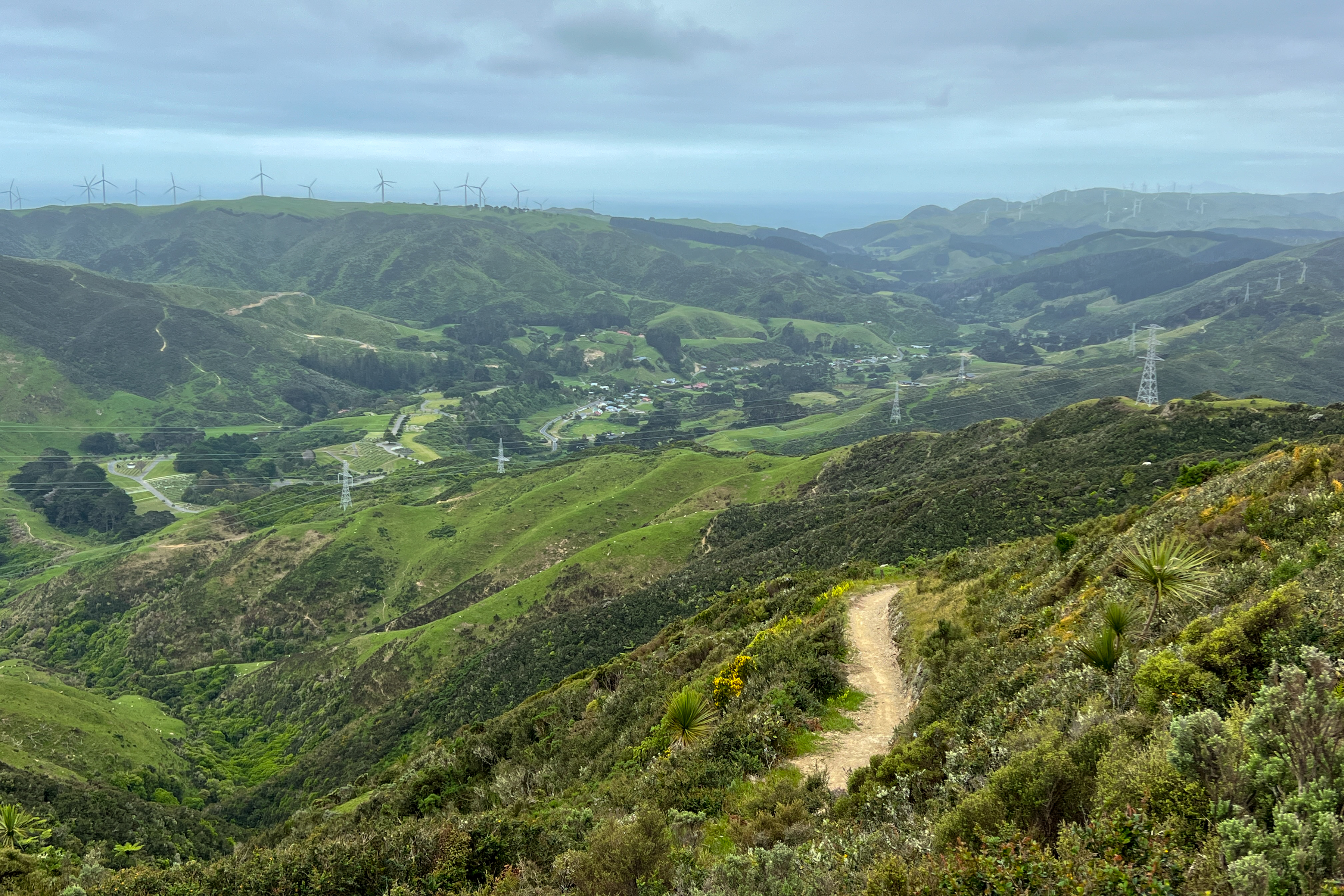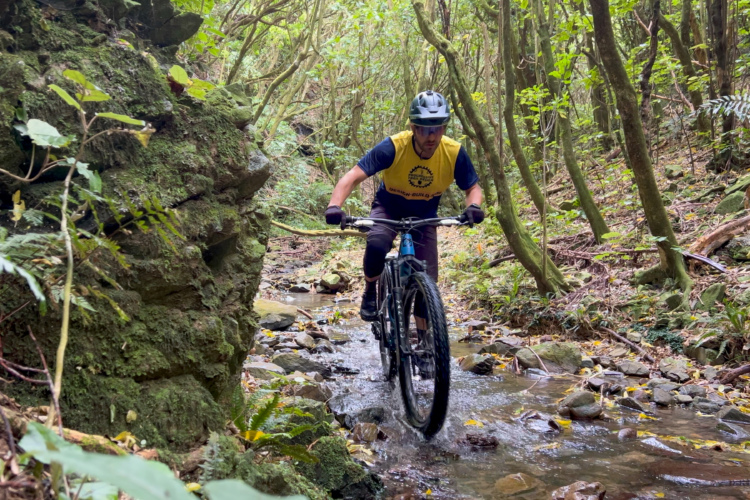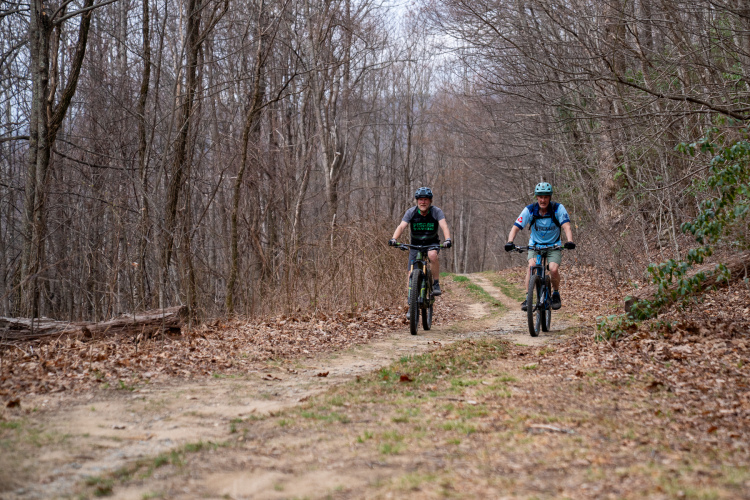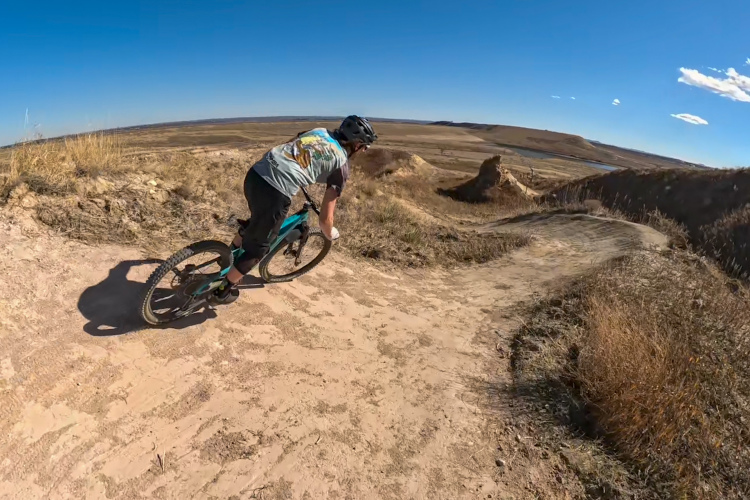
The city of Wellington, New Zealand, is quite likely the best national capital for mountain bike trail access in the world. And if there’s a jewel topping Wellington’s singletrack crown, that gemstone is the Makara Peak trail system.
Makara boasts 50km (31mi) of purpose-built mountain bike trails carved into the slopes of an almost 900-foot-tall mountain. While a few trails are open for two-way travel, the vast majority are designated for one-way travel.
I’ll get to the incredible singletrack in a bit, but first, Makara’s backstory is quite unusual.

Mountain bikers spearheaded the ecological restoration of Makara Peak
Beginning in the 1990s, residents of the city of Wellington began working to restore critical native habitat and species that had been decimated by colonization and invasive species.
One of the most significant ecological recovery efforts in the 1990s was turning what is now Zealandia into a bird sanctuary. To do this, a unique “North Korea-style fence” was constructed around the preserve, which cut off historic mountain bike access in the narrow, rugged valley. The conservation work in Zealandia has been extraordinarily successful. While scientists estimate it will take close to 500 years for the area to return to its original state, the work has begun.
“At the time, we used to be doing a lot of riding where Zealandia is now,” said Jono Baddiley, Past President of the Wellington Mountain Bike Club (WMBC) and long-time local mountain biker. Baddiley was riding mountain bikes around Wellington even before they began building singletrack, which kicked off in the early 90s.
“There was singletrack that would come off the top and drop down [to] the dam at the bottom of the hill,” Baddiley recalled. While Zealandia is now closed to bikes, it’s well worth a visit on foot for incredible bird spotting and its incredible natural beauty.
During this same period, a light was shone on the Makara Peak area, and how dramatically the land had been abused. Mountain bikers were seeking a new area where they could develop a purpose-built mountain bike trail system, and Makara Peak was given to the riders in 1998. “It was almost a quid pro quo,” said Baddiley. “We lost access to [Zealandia] when the fence was put in, and we gained Makara Peak and started building trails there.”

“Makara Peak was a private farm, and the landowner had been basically just dumping rubbish on there,” said Baddiley. “He was prosecuted by the council, and they did a land swap with him, and so took ownership of Makara Peak.” In addition to the blatant abuse of the land, Makara Peak had been overgrazed by sheep. Gorse and many other non-native species had also taken over the land.
While local mountain bikers were eager to build trails on Makara Peak, their mandate also included removing invasive species and planting native trees and plants.
“They started Makara Peak Supporters and really got involved in turning what was basically a barren scrubland into the native bush that it is now,” said Baddiley. “There’s been thousands of trees that have been planted there, and lots of rubbish removal and pest eradication and eradication of non-indigenous trees, like cutting down pine trees and cutting out all the cherry trees and things like that, so we can get native bush coming back.”
During the first 15 years of this work, mountain bikers planted over 35,000 native plants across the mountainside. Makara is now home to over 250 hectares of regenerating native bush.
The success of the wild kiwi population at Makara Peak is a massive environmental win
The ecological restoration project has been enormously successful. While it will take many years for the trees to grow to full height, the native bush is quickly returning to its natural state. Work is still ongoing: over 4,500 volunteer hours are invested in Makara Peak each year, including both trail maintenance and environmentalism.
One of the big successes at Makara Peak is the development of natural kiwi habitat. The flightless kiwi is one of the most unusual birds in the world and is the national bird of New Zealand. According to the New Zealand Department of Conservation, there used to be about 12 million kiwi in New Zealand. Now, there are about 70,000 left, and the country is losing about 2% of its native kiwi population per year.
But not on Makara Peak.
Kiwi have been reintroduced in the area and are now thriving in this wild habitat, which, as you can gather from the statistics, is extremely rare. Signs throughout the trail system mandate that all dogs be kept on leash to protect these incredible birds.
The story of Makara Peak is a stunning success for both ecological recovery in New Zealand and the construction of world-class mountain bike trails.

The trails at Makara Peak offer endless ride combinations
While Makara Peak is located further from the city center than both Mt. Vic and Waimapihi Reserve, it’s still less than 8km (5mi) from the heart of New Zealand’s capital city. I spent two weeks living car-free in Wellington, and I pedaled the roughly four miles each way from my AirBNB to Makara Peak three times, proving that a car isn’t required to reach these trails.
Almost all of the trail systems in Wellington feature trails for all skill levels, but Makara Peak truly offers something for everyone — from beginner to expert. Two climbing trails lead to the top of the mountain, and the green climbing trail is truly a green, with mellow grades and sculpted climbing corners that have been carved deep into the bedrock to maintain a consistent grade.



The main climb to the top of the mountain crosses the “Swing Bridge” — a massive suspension bridge spanning a gorge. While it’s tough to say from a brief scan of the landscape, it didn’t seem to me that the bridge was strictly required to pass through that terrain. Rather, it seemed that they simply wanted to build a spectacular and iconic feature on this bike-optimized climbing trail. I’ve never seen such a thing in a mountain bike trail system in the USA, and I doubt we ever will. Unless Bentonville says, “Hold my beer…”
Once at the top of the mountain, riders have a plethora of descents to choose from. Here’s a brief outline of the options, organized from easiest to most difficult.
Peak Flow -> Three Brothers -> Smokin’ -> Swigg
This trail combination provides an easy intermediate top-to-bottom flow trail descent (rated grade 3 in New Zealand, see below for equivalent US difficulty ratings) and is the easiest top-to-bottom run on the mountain. If you’re interested in a green/grade 2-rated descent, you can take Lazy Fern down from a hub lower on the mountain.
This trail combination consists entirely of classic flow trail, with sculpted berms and delightful rollers. There are few, if any, true jumps, but it’s still a crowd-pleaser.
North Face
North Face steps up the difficulty a notch from Peak Flow but still earns a grade 3 rating. After finishing the named North Face trail, a top-to-bottom run would also follow Three Brothers to Smokin’ to Swigg.

Zac’s Track -> Varley’s
This two-trail combination runs along a different aspect than most of the trails at Makara. Zac’s Track winds its way along the west/northwest side of the mountain, whereas most of the trails drop to the east. The long-distance views off the windswept west side of the mountain are arguably some of the best in the entire trail system. From this side, you can see active grazing still taking place on the mountainside and in the valley below, which gives you an idea of what the entire region might have looked like before the restoration efforts.
For a good top-to-bottom run, finish the descent to the paved road on Varley’s. Varley’s gets a grade 4 rating, but it’s a fairly achievable grade 4 descent, with some rocky switchbacks and a more natural singletrack feel. It’s roughly upper intermediate in difficulty.
Once you reach the paved road, you can climb back to the top of the mountain via the other main climbing trail: T4, which gets a grade 3, instead of a mostly grade 2 for most of the other track.

Pohatu -> Starfish
Pohatu is widely regarded as the marquee trail on Makara Peak. This grade 4 flow trail rides the line between intermediate and advanced. It consists primarily of big berms, rollers, and some tabletop jumps and ledge drops. Alt lines exist around the biggest features, and everything can be rolled (although the drops generally flow better if you send them).
A logical top-to-bottom run finishes with Starfish. Also a grade 4, Starfish feels a fair bit rougher and more technical than Pohatu, in part because it was one of the first trails built on the mountain. The roots and rocks are a bit slicker and trickier here. However, riders can also opt to finish on the easier Swigg trail instead.

Ridgeline
The grade 5 Ridgeline is the original mountain bike trail on Makara Peak.
“I think our ideas about building were pretty rudimentary,” said Baddiley. “We really had no idea what the hell we were doing. We didn’t even have proper tools. It was kind of going in with a spade and a grubber and a machete, because we didn’t have axes or chainsaws or anything.”
Since those earlier days, many of the original tracks have been rebuilt, but Ridgeline retains a raw, rocky character. The trail contains several small rock slab rides and raucous rock gardens, with a few small but somewhat tricky ledge drops.
This grade 5 trail would earn a solid single black diamond rating in most places in the States.
For a top-to-bottom run, finish with Starfish.

Wha Out -> Vertigo
Wha Out is rated grade 4, with Vertigo as a grade 5. The steep, rooty, and sometimes slippery Vertigo is filled with a few sketchy drops. In most places in the States, it would probably get a double black diamond rating. One noteworthy feature concludes the trail: a bridge crossing leading to a steep rock roll corkscrew that drops to the left-hand side. A steep roll down slippery rock splashes into the flowing stream, with the trail/stream flowing under the bridge and the singletrack resuming on the same bank it originally left.
Vertigo runs into Trickle Falls for the finish.
Trickle Falls
Trickle Falls was the most difficult trail at Makara Peak until the construction of Yeah Gnar. According to reports, everything is rollable, but if you can’t handle the filter feature at the top, you’ll definitely be in trouble lower down the trail.
The named Trickle Falls trail offers a complete top-to-bottom run.
Yeah Gnar
Yeah Gnar is renowned as the most technical trail in the entire Wellington Area. As we know, nobody can agree on difficulty ratings, but the locals can all agree that Yeah Gnar is the gnarliest!
The trail maps at Makara Peak give Yeah Gnar a grade 6 difficulty rating, which wasn’t originally included in the New Zealand trail rating system. However, some destinations in New Zealand are adopting grade 6 for their truly most difficult trails, which would easily be double black in the USA.

After riding a grade 5 trail in Wainuiomata that scared the shit out of me, I opted to pass on Yeah Gnar. However, after riding more widely across New Zealand, I can safely say that most New Zealand grade 5 tracks are roughly equivalent to a black diamond in the USA, albeit with potentially a higher bar for the rating to be switched to a grade 6. And of course, there’s plenty of variance from one area to another.
Based on my experience, here’s a conversion chart for New Zealand ratings to USA ratings:
- Grade 1: Flat gravel path — not singletrack
- Grade 2: Green — beginner
- Grade 3: Green/Blue — intermediate
- Grade 4: Blue/Black — upper intermediate
- Grade 5: Black — advanced
- Grade 6: Double black — extreme
A top-to-bottom run on Yeah Gnar concludes on Trickle Falls.

But wait, there’s more…
Despite that seemingly-exhaustive trail analysis, there are even more trail segments and ride combinations available on Makara Peak! Old school trails like Nikau Valley are both beautiful and entertaining, and easier loops can also be found near the base of the mountain. Makara Peak is truly a spectacular trail system and is more than worthy of a few days of pedaling on your next visit to Wellington.









0 Comments